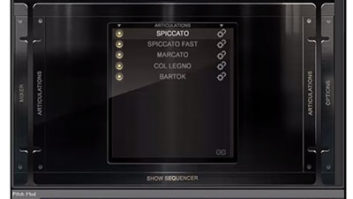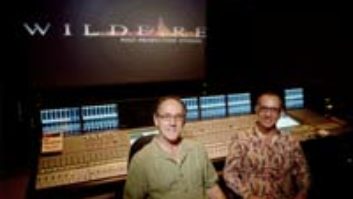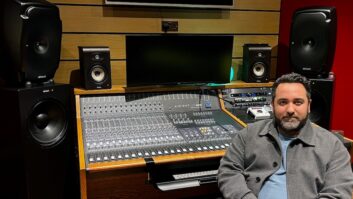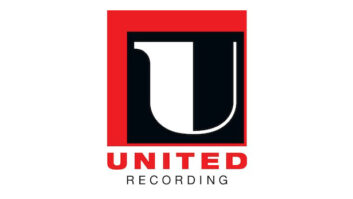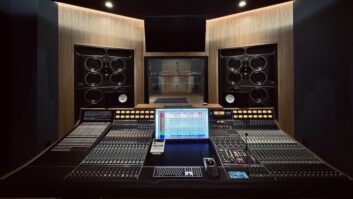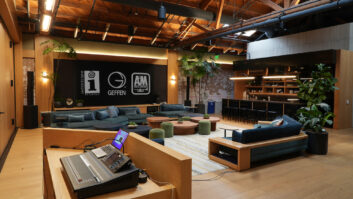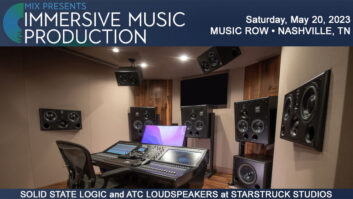
Chris David (left) and Leslie Shatz at the SSL C300HD board
Photo: Edward Colver
Leslie Shatz and Chris David can admit now that when they first floated the idea of buying Wilshire Stages two years ago, the industry response was less than encouraging. It was more like, “Are you nuts? Buying a facility in L.A.? In today’s cut-costs, consolidate-now economy?”
They listened to the skeptics. They did due diligence on the post-production market. And in early 2007 they purchased the four-mix-stage analog facility, renamed it Wildfire Post-Production Studios and set about updating the cosmetics and the technology backbone.
“It was a leap of faith,” Shatz recalls during a break on the mix of Jeffrey Nachmanoff’s Traitor. “But we had good timing on the price, and thankfully the writers’ strike didn’t seem to affect the types of projects we do. But we feel like we’re in a market that has properly adjusted, with room for an independent facility and the freedom that brings a filmmaker.”
To be fair, Shatz and David brought a lot of those filmmakers with them. Between the two of them, they have a combined 60 years of experience in film sound, most of it as re-recording mixers. Shatz logged many years in the San Francisco Bay Area, going back to Apocalypse Now, Rumble Fish, Ghost and Dracula, among many others. David, who has run a recording studio in Bristol, England, as a side job for 30 years, counts Legends of the Fall (for which he received an Academy Award nomination), Clueless, Donnie Darko, Alexander and many others among his films. They’ve worked on big-budget and quirky, comedy and action. They are owner/operators, and that might just prove to be their biggest advantage.
“We both had done a fair amount of work on these stages in their previous existence,” says David, who has assumed the role of president and runs the business and technology ends of the operation. (Shatz is technically the senior VP and handles sales, marketing and “vibe.”) “They needed some updating, but we both saw the possibilities. One of the first things we did was take the Series Twelve out of the C Stage and put in an SSL C300HD [pictured on this month’s cover]. We know that it’s going against the mainstream here in town, but it’s a straight-up digital console with great sound, and it’s a workstation control surface. We work very much in both worlds, especially Leslie.”
Shatz, an Academy Award-nominated sound designer and mixer, constantly moves back and forth from console to control, typically honing the dialog in Pro Tools, mixing music on the board and employing a combo of the two on effects. He bounces from an upstairs 5.1 sound design room, to premixing on the SSL, to finalizing on the Harrisons in the A or B stage. The first week, he did not like the SSL.
“I hated it!” he says with a laugh. “And now I love it! I just did the final for Gomorra on it. We just had to get up and running. It’s very simple once you embrace the Master section. You can control such a large number of channels when you’re one-man mixing, and having the automated Pro Tools software is just great. I’m using the Waves C4 for noise reduction and compression, their de-esser, [and] the Roger Nichols Uniquel-izer is great for notches. I feel completely confident when I trim parameters and work the dialog.”
The other major facility improvement, in addition to the more hang-friendly cosmetics of the common areas, was the addition of digital intermediate on the B stage through a partnership with Hollywood Intermediate. The scan-effect-color grading process, used on films big and small, typically takes place at the same time as the final mix. Producers who are not on a lot can end up spending a lot of down time driving from sound to picture and back again.
“We put Barco DP90P 2k projectors in the A and B stages,” David explains. “We originally thought of converting our ADR room to DI, but then we came up with the idea of making a dual-purpose mix room out of B. We now have one of the largest DI rooms in town, and in 15 minutes we can switch from sound to picture and the producer can walk back and forth without leaving the building.”
It’s a good thing they didn’t take down the ADR room, as mixer Eric Thompson “has been going gangbusters,” Shatz says. “Rambo was really the first film to take advantage of all the rooms. We did the sound design, the editorial, the DI, premix, ADR, final mix. All of the rooms working. And Sylvester spent a lot of time just hanging at the facility. So it was comfortable, and the vibe was right.”
Shatz and David have put together a team that includes Thompson, business manager Dan Medina and director of business development Diana Blake. The final piece of the puzzle will be to one day replace the analog Harrisons in A and B, but Shatz and David are taking “baby steps,” as Shatz says, and for now there seems to be a few filmmakers who still love that warmth.
So today they can breathe a little easier. They’ve had a year of steady work, punctuated by a few high-profile projects (I’m Not There, John Rambo, Juno), and they’re booked through 2008 with a slate that includes the highly anticipated Harvey Milk film by Gus Van Sant.
“As a mixer, I like the variety,” Shatz says. “And as an owner, I like that we have all five rooms working. We’re looking forward to a good year.”
Tom Kenny is Mix‘s editorial director.
